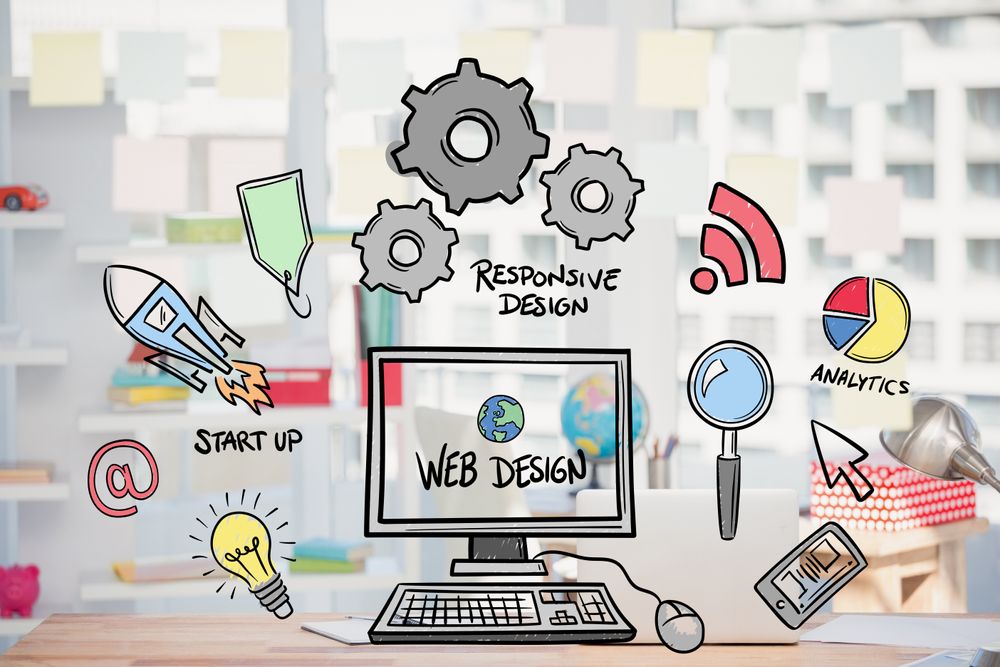The complete guide to hiring a Web Design Agency for your business success
Essential Tips for Enhancing Your Online Presence With Web Design
In today's digital landscape, web design plays a necessary duty in forming an on the internet visibility. A well-structured site can considerably improve user interaction and brand identity. Key aspects such as user experience, mobile optimization, and load rate are crucial considerations. Recognizing these parts can make a considerable difference. What particular methods can be employed to effectively apply these style concepts? Discovering these facets will certainly expose more regarding enhancing online exposure.
Prioritize User Experience (UX)
When designing a website, focusing on user experience (UX) is important for making sure that visitors can browse the website successfully and involve with its material. A well-structured layout assists users find information promptly, minimizing irritation and enhancing the probability of return check outs. Crucial element such as intuitive navigation, clear telephone calls to activity, and aesthetically attractive layout contribute considerably to a favorable UX.
Consistency in design elements, including shade schemes and typography, promotes experience and trust fund. Focus to tons times is also important; fast-loading web pages keep individuals, while delays can result in high bounce rates. Incorporating responses devices, such as surveys or call kinds, allows companies to understand user needs and improve accordingly. Inevitably, a concentrate on UX not just enhances site visitor contentment but likewise supports the total objectives of the internet site, driving conversions and building a faithful target market.
Optimize for Mobile Tools
In today's digital landscape, optimizing for mobile phones is essential for reliable web design. This includes implementing responsive design, guaranteeing quickly loading times, and including touchscreen navigation functions. These components jointly boost user involvement and fulfillment on mobile platforms.
Receptive Style Value
Responsive style stands as a cornerstone of modern-day web development, making certain that websites function flawlessly throughout numerous tools, particularly smart phones. As mobile phone use remains to increase, individuals anticipate a consistent experience despite display dimension. A responsive design adjusts the design, photos, and capabilities to various tools, improving usability and involvement. This flexibility is essential, as it enables businesses to get to broader audiences without the demand for different mobile sites. Furthermore, online search engine favor receptive websites in their positions, making it vital for exposure in a crowded digital landscape. Inevitably, buying receptive layout is not merely concerning aesthetic appeals; it is a critical approach that enhances user experience and drives possible conversions.
Fast Loading Times
Quick packing times are essential for enhancing mobile gadgets, as individuals significantly expect immediate access to info - Web Design services. A site that lots quickly boosts user fulfillment and decreases bounce prices. Mobile customers usually gain access to websites on-the-go, where slow loading can lead to frustration and abandonment. To achieve rapid loading times, web designers must prioritize photo optimization, decrease HTTP demands, and use caching strategies. In addition, using material delivery networks (CDNs) can better improve lots speed by distributing material closer to customers. Simplifying the web site's code and leveraging asynchronous packing for scripts can likewise add to better performance. Inevitably, a fast-loading website not only sustains user interaction however also positively influences search engine positions, making it a critical facet of effective web design
Touchscreen Navigation Features
A smooth user experience on smart phones greatly depends on effective touchscreen navigating attributes. Designers have to focus on user-friendly layouts that accommodate motions such as touching, swiping, and pinching. Large, easily tappable switches minimize user aggravation and boost functionality, permitting smoother communications. Additionally, including aesthetic responses, such as highlighting buttons when pushed, can considerably boost user interaction.
Executing a consistent navigation structure across pages help in user orientation, making it easier for visitors to find info. Responsive layout warranties that elements resize appropriately for numerous screen dimensions, maintaining use. Ultimately, decreasing the demand for scrolling and offering fast access to essential features will certainly aid users navigate successfully, ultimately promoting a positive online experience.
Concentrate On Load Rate
While website aesthetics and capability are very important, focusing on load speed is essential for retaining visitors and boosting total user experience. Study shows that users expect websites to fill in under three seconds; anything longer can lead to increased bounce prices. A slow-loading site discourages customers and diminishes the chance of keeping their interest.
To enhance load rate, internet designers need to enhance picture sizes, reduce HTTP requests, and take advantage of web browser caching. Furthermore, making use of content shipment networks (CDNs) can distribute material much more efficiently throughout numerous locations, causing quicker access times.
Eliminating unneeded plugins and manuscripts can lower load times substantially. Regularly evaluating website speed utilizing devices like Google PageSpeed Insights aids identify areas for improvement. By concentrating on tons rate, services can create an extra smooth surfing experience, eventually encouraging user interaction and increasing conversion rates. Speed is not just a technical element; it's an important part of user satisfaction.
Carry Out Clear Navigation
Effective navigating functions as the backbone of a straightforward website, guiding visitors effortlessly with its web content. A well-structured navigation system guarantees that customers can conveniently find the information they seek, enhancing their general experience. It is necessary to prioritize simplicity; menus must be straightforward, with clear labels that properly stand for the equivalent pages.
Organizing web content right into logical groups can additionally assist in quicker accessibility, assisting users navigate without feeling bewildered. Carrying out breadcrumb tracks allows visitors to track their journey through the website, giving context and making it possible for easy backtracking.

Make Use Of Involving Visuals
Incorporating appealing visuals can significantly boost a website's charm and efficiency, as they catch user attention and share info more dynamically than text alone. Premium pictures, videos, and infographics can create a memorable user experience, encouraging site visitors to invest more time on the site. Visuals can also assist in narration, enabling brands to connect their message more successfully and stimulate psychological responses.
Using a regular shade combination and layout style can additionally strengthen the general aesthetic influence. Interactive elements, such as sliders or computer animations, can likewise involve individuals, making navigating extra delightful. Furthermore, visuals should be maximized for fast filling times to avoid frustrating delays that could drive users away. Eventually, a thoughtful integration of engaging visuals can not only enhance visual charm however likewise enhance user comprehension and retention, causing higher interaction and conversion prices.
Maintain Regular Branding
Keeping consistent branding across a website is crucial for fostering and developing a solid identification trust fund with site visitors. This uniformity encompasses internet numerous elements, including shade systems, typography, logo designs, and imagery. By making certain that these parts straighten with the brand name's core message, companies can create a cohesive experience that reverberates with users.
A well-defined brand name identity not just boosts recognition however also reinforces consumer loyalty. When site visitors come across an uniform look and really feel, they are most likely to perceive the brand as professional and trustworthy. Irregular branding, on the other hand, can lead to confusion and lessen the total user experience.

Integrate SEO Ideal Practices
Creating a solid brand identity is just part of the equation for an impactful site; optimizing for search engines is similarly crucial. Including search engine optimization ideal techniques warranties that a website ranks greater in internet search engine results, making it extra noticeable to potential customers. This includes utilizing appropriate search phrases throughout the site's web content, including titles, headers, and meta descriptions, which help look engines understand the site's purpose.
Furthermore, maximizing photos with alt tags and assuring quick packing times boosts user experience and decreases bounce rates. A mobile-friendly layout is vital, as even more users access the web using mobile devices. Interior linking between pages can enhance site navigating and maintain site visitors engaged longer. On a regular basis upgrading web content with fresh information signals to browse engines that the website is active, which can positively affect rankings. By incorporating these techniques, organizations can significantly enhance their online presence and attract more website traffic to their internet sites.
Regularly Asked Concerns
Exactly How Can I Determine the Performance of My Web Design?
To measure web design performance, one can evaluate user engagement metrics, display conversion prices, conduct A/B screening, collect user feedback, and evaluate click for source website performance via analytics devices, making certain continuous enhancement and alignment with user needs.
What Tools Can Assist With Web Design Analytics?
Google Analytics, Hotjar, and Adobe Analytics are effective devices for web design analytics. Web Design services. These systems enable customers to track visitor behavior, analyze traffic sources, and measure engagement, supplying important understandings for enhancing style performance and user experience
How Frequently Should I Update My Website Layout?
An internet site layout must be updated a minimum of every year to stay relevant and appealing. Nevertheless, constant updates might be required based upon user responses, advancing trends, or considerable modifications in organization goals or offerings.
What Are the Typical Web Design Blunders to Stay Clear Of?
Common web design mistakes consist of overly chaotic layouts, poor navigating, irregular branding, disregarding mobile responsiveness, slow loading times, and ignoring user experience. Preventing these challenges can significantly boost a site's effectiveness and user interaction.
Just How Can I Guarantee My Web Site Is Obtainable to Every person?

Prioritize User Experience (UX)
When designing a developing, internet site user focusing on (UX) is essential for crucial that guaranteeing can navigate the site effectively website efficiently with involve content. A web site that tons swiftly enhances user contentment and lowers bounce prices. While website looks and capability are essential, prioritizing load speed is essential for preserving visitors and boosting general user experience. A mobile-friendly design is important, as more users access the internet by means of mobile devices. Common web layout errors include overly cluttered formats, poor navigation, irregular branding, overlooking mobile responsiveness, sluggish packing times, and neglecting user experience.